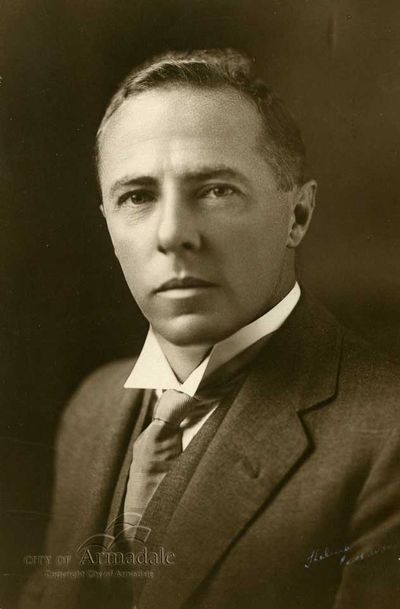Ivor Trehane Birtwistle
From Our Contribution
 Courtesy Birtwistle Local Studies Library | |
| Personal Information | |
|---|---|
| Date of Birth | 8 Apr 1892 |
| Place of Birth | Beaumaris, Melbourne, Victoria |
| Death | 15 Jun 1976, aged 84 |
| Place of Death | Roleystone, Western Australia |
| Age at Enlistment | 22 years, 10 months |
| Description | 5'3", 127 lbs, medium complexion, hazel eyes and dark brown hair |
| Occupation | journalist |
| Religion | Presbyterian |
| Address | 45 Austin street, Subiaco, Western Australia |
| Next of Kin | Father Mr James Birtwistle |
| Military Information | |
| Reg Number | 730 |
| Date of Enlistment | 13 Feb 1915 |
| Rank | Lance Corporal |
| Unit/Formation | 22nd Battalion, B Company / 6th Brigade, 2nd Division |
| Date of Embarkation | 8 May 1915 - ? Jun 1915 |
| Ship Embarked On | HMAT A38 Ulysses |
| Date of Return | 22 Feb 1917 - 10 Apr 1917 |
| Ship Returned On | HMAT A63 Karoola |
| Fate |
Wounded in Action 27 Jul 1916 Returned to Australia |
| Medals |
1914-15 Star British War Medal Victory Medal Queen Elizabeth II Coronation Medal |
Pre War
Son of James Birtwistle, architect, and his wife Emily, née Davies, both Victorian born. The family moved to Perth where Ivor attended Claremont State School. In 1908 he was employed as a fileroom-boy by the Western Mail and apparently remained with that weekly until 1912 when his involvement with the Presbyterian Church led to his editing the Presbyterian. In 1913 he became an ordinand in the Church's Home Mission; following some months at Beverley, he resigned to join the literary staff of the Melbourne Age.[1]
There was a history of nervous issues in Ivor's family. In 1912 for instance, he had suffered a nervous breakdown from over study which affected him for 4 months.
War Service
A previous attempt to enlist was rejected due to his height. On 1 May 1915 he entered Broadmeadows camp in Victoria, and after a week's training, travelled to Egypt.
On 14 Dec 1916 he was admitted to No1 Australian General Hospital in Heliopolis with septic legs, and following treatment was sent to the 1st Australian Auxiliary Hospital to recover. Total time in hospital was nine weeks. He rejoined his unit in Zeitoun on 11 Mar 1916, and it then sailed from Alexandria aboard HMHS Llandovery Castle on 19 Mar 1916, disembarking in Marseilles on 26 Mar 1916.
Ivor's records show that he participated in a large (252 man) raid on enemy trenches on the night of 29th-30th June, and following this period of familiarisation in the Bois Grenier sector, the 22nd Battalion relieved the 6th Battalion in the Pozieres front line at 4.30am on 27 Jul 1916.
Enemy shelling of their position at Poziéres occurred from 6.30 - 7.15am, and after a brief lull, very intense shelling began at 7.30am and continued throughout the day and night. Casualties for the day were 20 killed, 134 wounded and 19 missing. Similar shelling, causing a similar level of casualties was also suffered the following day.
While his records show that Ivor was Wounded in Action during the period 27 Jul to 4 Aug 1916, he received medical attention on the 28th. Suffering from shellshock, having been buried when shells collapsed the trench on top of him, on 28 Jul he was admitted to the 22nd General Hospital at Camiers in France. He was then evacuated on 12 Aug 1916 aboard HMHS Brighton from Calais for England.
In France, he was blown 10 feet (3m) by a shell on 25 Jun 1916, and was buried, subsequently suffering shell shock . On 26 Jul he was twice buried by trenches collapsing under shellfire. After being dug out after several hours, he was found to be alive but unconscious. He was treated by a number of hospitals between the battle field and the safety of the 3rd Australian Auxiliary Hospital where he was admitted suffering with intermittent headaches, slight giddiness, fairly constant tremors, disturbed sleep, dreams and general nervousness preventing him walking and even standing. These symptoms recurred with sudden noises.
On 13 Aug 1916 he was admitted to the 5th Northern Hospital in England for treatment, before transferring on 4 Nov 1916 to the Military Hospital at Maghull in Leicester, and then on 17 Nov 1916 to the 3rd Australian Auxiliary Hospital. On 22 Feb 1917 he was invalided home on the HMAT A63 Karoola which was acting as a Hospital Ship, with nervous debility and shell shock.
Treatment back in Australia included general massage for legs , and on 24 Mar 1917 under anaesthetic his legs were cauterised in 8 places. Granted a pension of £3 per fortnight from 23 Jun 1917, it was withdrawn when he travelled to New Guinea and the Solomon Islands on 3 Jan 1918.
Discharged 12 Jun 1917 in Melbourne.
Post War
On 25 Nov 1925 Ivor married Kathleen Winifred Broadley in Perth. Their son Ross was born 10 Sep 1926 and daughter Helen on 27 Apr 1929.
Served during WW2 in the militia with regimental No W66833.
Notes
Retired to Roleystone after a very successful journalistic career. In retirement he was the driving force to create a museum in Armadale. The Local Studies Library in Armadale is named in his honour.
A more comprehensive biography is available via the Australian Dictionary of Biography hyperlink below.